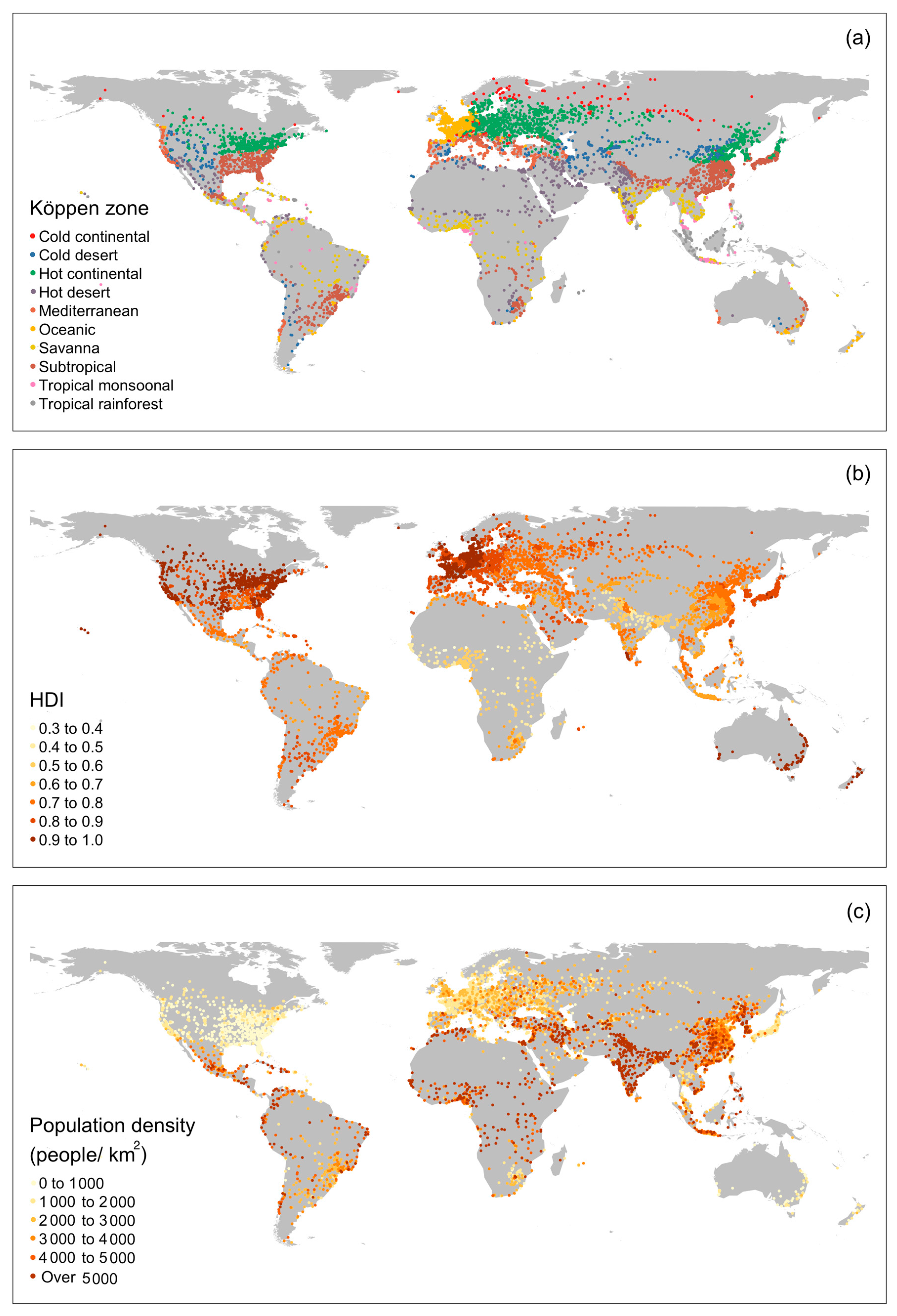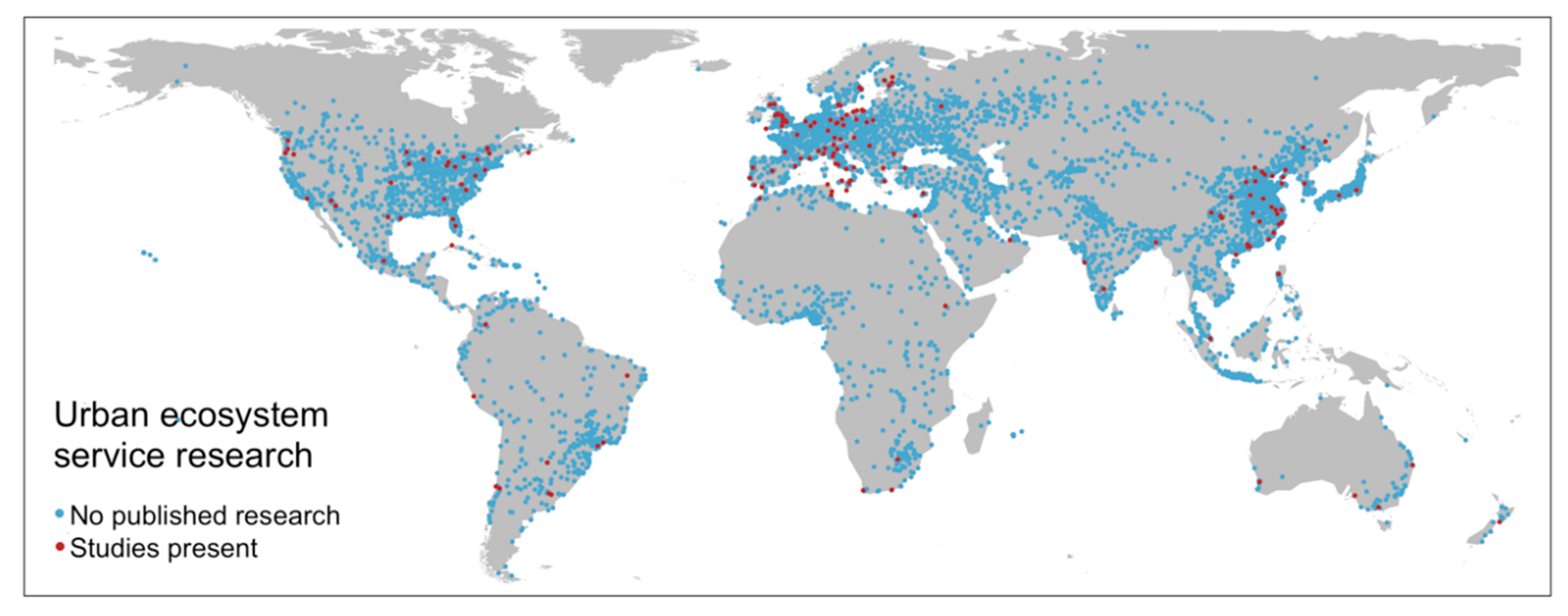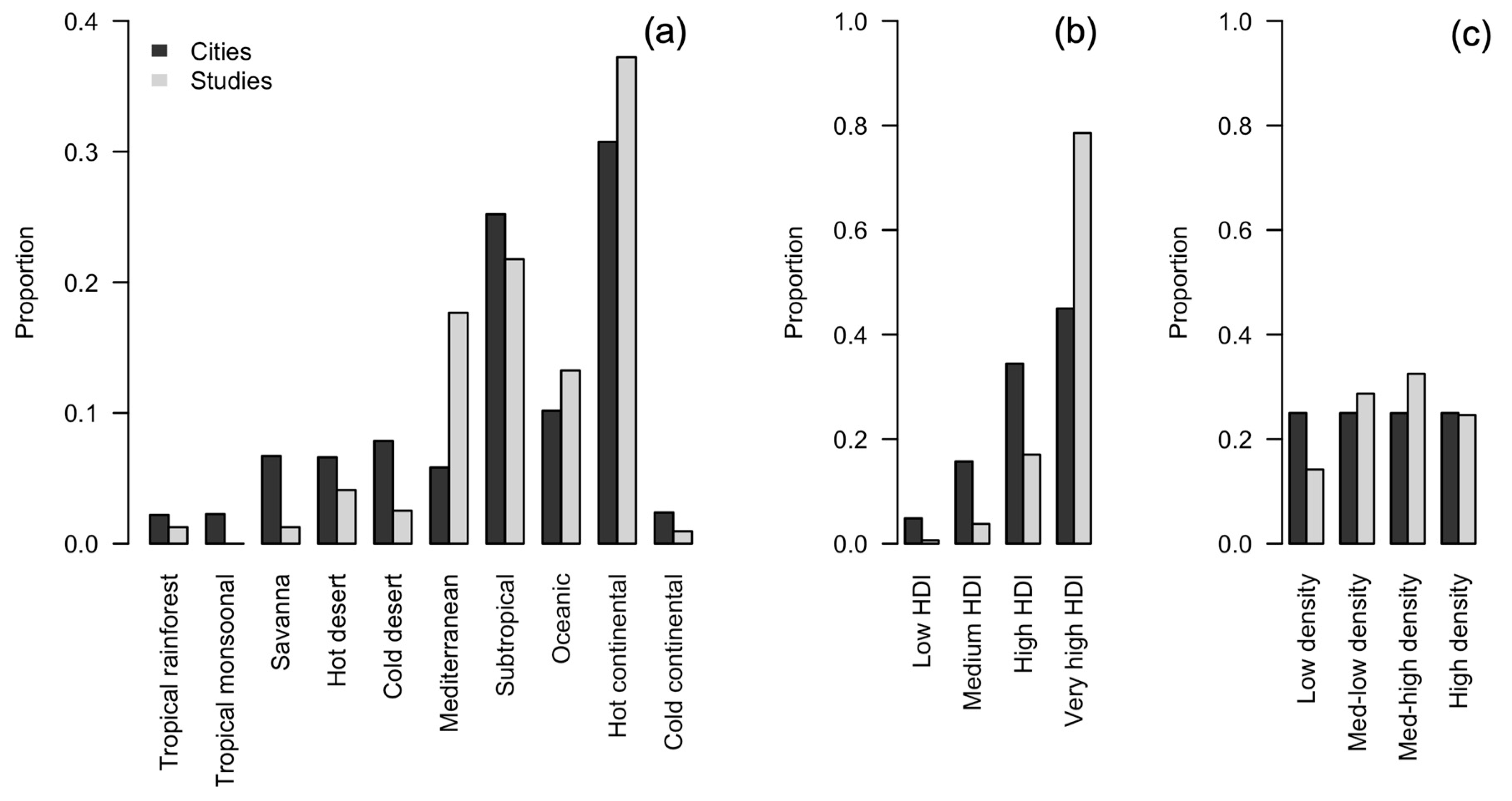Global Variation in Climate, Human Development, and Population Density Has Implications for Urban Ecosystem Services
Abstract
1. Introduction
2. Materials and Methods
2.1. Characteristics of Urban Areas
2.2. Review of Urban Ecosystem Services Literature
3. Results
3.1. Global Variation in Urban Climate, Human Development, and Population Density
3.2. Representativeness of Published Research into Urban Ecosystem Services
4. Discussion
4.1. Variation between Cities and Implications for Ecosystem Services
4.1.1. Implications of Climatic Variation for Urban Ecosystem Services
4.1.2. Implications of Variation in HDI for Urban Ecosystem Services
4.1.3. Implications of Population Density Variation for Urban Ecosystem Services
4.2. Representativeness of Published Research into Urban Ecosystem Services
5. Conclusions
Author Contributions
Funding
Acknowledgments
Conflicts of Interest
References
- Elmqvist, T.; Setälä, H.; Handel, S.N.; van der Ploeg, S.; Aronson, J.; Blignaut, J.N.; Gómez-Baggethun, E.; Nowak, D.J.; Kronenberg, J.; de Groot, R. Benefits of restoring ecosystem services in urban areas. Curr. Opin. Environ. Sustain. 2015, 14, 101–108. [Google Scholar] [CrossRef]
- Bolund, P.; Hunhammar, S. Ecosystem services in urban areas. Ecol. Econ. 1999, 29, 293–301. [Google Scholar] [CrossRef]
- Bowler, D.E.; Buyung-Ali, L.; Knight, T.M.; Pullin, A.S. Urban greening to cool towns and cities: A systematic review of the empirical evidence. Landsc. Urban Plan. 2010, 97, 147–155. [Google Scholar] [CrossRef]
- Berland, A.; Shiflett, S.A.; Shuster, W.D.; Garmestani, A.S.; Goddard, H.C.; Herrmann, D.L.; Hopton, M.E. The role of trees in urban stormwater management. Landsc. Urban Plan. 2017, 162, 167–177. [Google Scholar] [CrossRef]
- Mcdougall, R.; Kristiansen, P.; Rader, R. Small-scale urban agriculture results in high yields but requires judicious management of inputs to achieve sustainability. Proc. Natl. Acad. Sci. USA 2019, 116, 129–134. [Google Scholar] [CrossRef]
- Wolch, J.R.; Byrne, J.; Newell, J.P. Urban green space, public health, and environmental justice: The challenge of making cities “just green enough”. Landsc. Urban Plan. 2014, 125, 234–244. [Google Scholar] [CrossRef]
- Mcdonnell, M.J.; Macgregor-Fors, I. The ecological future of cities. Science 2016, 352, 936–938. [Google Scholar] [CrossRef]
- Wu, J. Urban ecology and sustainability: The state-of-the-science and future directions. Landsc. Urban Plan. 2014, 125, 209–221. [Google Scholar] [CrossRef]
- Zhou, Y.; Smith, S.J.; Zhao, K.; Imhoff, M.; Thomson, A.; Bond-Lamberty, B.; Asrar, G.R.; Zhang, X.; He, C.; Elvidge, C.D. A global map of urban extent from nightlights. Environ. Res. Lett. 2015, 10, 054011. [Google Scholar] [CrossRef]
- Nagendra, H.; Bai, X.; Brondizio, E.S.; Lwasa, S. The urban south and the predicament of global sustainability. Nat. Sustain. 2018, 1, 341–349. [Google Scholar] [CrossRef]
- Freire, S.; Pesaresi, M. GHS Population Grid, Derived from GPW4, Multitemporal (1975, 1990, 2000, 2015). Available online: https://data.europa.eu/euodp/en/data/dataset/jrc-ghsl-ghs_pop_gpw4_globe_r2015a (accessed on 1 October 2018).
- Kottek, M.; Grieser, J.; Beck, C.; Rudolf, B.; Rubel, F. World map of the Köppen-Geiger climate classification updated. Meteorol. Z. 2006, 15, 259–263. [Google Scholar] [CrossRef]
- Jendritzky, G.; Tinz, B. The thermal environment of the human being on the global scale. Glob. Health Action 2009. [Google Scholar] [CrossRef] [PubMed]
- Mora, C.; Dousset, B.; Caldwell, I.R.; Powell, F.E.; Geronimo, R.C.; Bielecki, C.R.; Counsell, C.W.W.; Dietrich, B.S.; Johnston, E.T.; Louis, L.V.; et al. Global risk of deadly heat. Nat. Clim. Chang. 2017, 7, 501–506. [Google Scholar] [CrossRef]
- Vollmer, D.; Grêt-Regamey, A. Rivers as municipal infrastructure: Demand for environmental services in informal settlements along an Indonesian river. Glob. Environ. Chang. 2013, 23, 1542–1555. [Google Scholar] [CrossRef]
- Zezza, A.; Tasciotti, L. Urban agriculture, poverty, and food security: Empirical evidence from a sample of developing countries. Food Policy 2010, 35, 265–273. [Google Scholar] [CrossRef]
- Tsai, Y.H. Quantifying urban form: Compactness versus “sprawl”. Urban Stud. 2005, 42, 141–161. [Google Scholar] [CrossRef]
- Soga, M.; Gaston, K.J. Extinction of experience: The loss of human-nature interactions. Front. Ecol. Environ. 2016, 14, 94–101. [Google Scholar] [CrossRef]
- Song, X.P.; Tan, P.Y.; Edwards, P.; Richards, D. The economic benefits and costs of trees in urban forest stewardship: A systematic review. Urban For. Urban Green. 2018, 29, 162–170. [Google Scholar] [CrossRef]
- Keeler, B.L.; Hamel, P.; McPhearson, T.; Hamann, M.H.; Donahue, M.L.; Meza Prado, K.A.; Arkema, K.K.; Bratman, G.N.; Brauman, K.A.; Finlay, J.C.; et al. Social-ecological and technological factors moderate the value of urban nature. Nat. Sustain. 2019, 2, 29–38. [Google Scholar] [CrossRef]
- Jim, C. Green-space preservation and allocation for sustainable greening of compact cities. Cities 2004, 21, 311–320. [Google Scholar] [CrossRef]
- Gómez-Baggethun, E.; Barton, D.N. Classifying and valuing ecosystem services for urban planning. Ecol. Econ. 2013, 86, 235–245. [Google Scholar] [CrossRef]
- Tratalos, J.; Fuller, R.A.; Warren, P.H.; Davies, R.G.; Gaston, K.J. Urban form, biodiversity potential and ecosystem services. Landsc. Urban Plan. 2007, 83, 308–317. [Google Scholar] [CrossRef]
- Luederitz, C.; Brink, E.; Gralla, F.; Hermelingmeier, V.; Meyer, M.; Niven, L.; Panzer, L.; Partelow, S.; Rau, A.-L.; Sasaki, R.; et al. A review of urban ecosystem services: Six key challenges for future research. Ecosyst. Serv. 2015, 14, 98–112. [Google Scholar] [CrossRef]
- Song, X.P.; Richards, D.; Edwards, P.J.; Tan, P.Y. Benefits of trees in tropical cities. Science 2017, 356, 6344. [Google Scholar] [CrossRef] [PubMed]
- Plummer, M.L. Assessing benefit transfer for the valuation of ecosystem services. Front. Ecol. Environ. 2009, 7, 38–45. [Google Scholar] [CrossRef]
- Wu, L.; Wang, Z.; Mao, X. How multilateral financial institutions promote sustainable water infrastructure planning through economic appraisal: Case studies from coastal cities of China. J. Environ. Plan. Manag. 2018, 61, 1402–1418. [Google Scholar] [CrossRef]
- Richards, D.R.; Passy, P.; Oh, R.R.Y. Impacts of population density and wealth on the quantity and structure of urban green space in tropical Southeast Asia. Landsc. Urban Plan. 2017, 157, 553–560. [Google Scholar] [CrossRef]
- Esch, T.; Heldens, W.; Hirner, A.; Keil, M.; Marconcini, M.; Roth, A.; Zeidler, J.; Dech, S.; Strano, E. Breaking new ground in mapping human settlements from space—The Global Urban Footprint. ISPRS J. Photogramm. Remote Sens. 2017, 134, 30–42. [Google Scholar] [CrossRef]
- Richards, D.R.; Edwards, P.J. Using water management infrastructure to address both flood risk and the urban heat island. Int. J. Water Resour. Dev. 2018, 34, 490–498. [Google Scholar] [CrossRef]
- Manoli, G.; Fatichi, S.; Schläpfer, M.; Yu, K.; Thomas, W.; Katul, G.G.; Bou-zeid, E. Magnitude of urban heat islands largely explained by climate and population. Nature 2019, 573, 55–60. [Google Scholar] [CrossRef]
- Qi, W.; Liu, S.; Gao, X.; Zhao, M. Modeling the spatial distribution of urban population during the daytime and at night based on land use: A case study in Beijing, China. J. Geogr. Sci. 2015, 25, 756–768. [Google Scholar] [CrossRef]
- Wilson, J.; Tyedmers, P.; Pelot, R. Contrasting and comparing sustainable development indicator metrics. Ecol. Indic. 2007, 7, 299–314. [Google Scholar] [CrossRef]
- Kummu, M.; Taka, M.; Guillaume, J.H.A. Data Descriptor: Gridded global datasets for Gross Domestic Product and Human Development Index over 1990–2015. Sci. Data 2018, 5, 180004. [Google Scholar] [CrossRef]
- Dobbs, C.; Nitschke, C.R.; Kendal, D. Global Drivers and Tradeoffs of Three Urban Vegetation Ecosystem Services. PLoS ONE 2014, 9, e113000. [Google Scholar] [CrossRef] [PubMed]
- Human Development Indices and Indicators: 2018 Statistical Update. Available online: http://hdr.undp.org/en/content/human-development-indices-indicators-2018-statistical-update (accessed on 1 October 2018).
- Lan, L.; Lian, Z.; Pan, L. The effects of air temperature on office worker’s well-being, workload and productivity-evaluated with subjective ratings. Appl. Ergon. 2010, 42, 29–36. [Google Scholar] [CrossRef] [PubMed]
- Roth, M. Review of urban climate research in (sub)tropical regions. Int. J. Climatol. 2007, 26, 1859–1873. [Google Scholar] [CrossRef]
- Zhang, Z.; Lv, Y.; Pan, H. Cooling and humidifying effect of plant communities in subtropical urban parks. Urban For. Urban Green. 2013, 12, 323–329. [Google Scholar] [CrossRef]
- Lee, X.; Goulden, M.L.; Hollinger, D.Y.; Barr, A.; Black, T.A.; Bohrer, G.; Bracho, R.; Drake, B.; Goldstein, A.; Gu, L.; et al. Observed increase in local cooling effect of deforestation at higher latitudes. Nature 2011, 479, 384–387. [Google Scholar] [CrossRef]
- Huong, H.T.L.; Pathirana, A. Urbanization and climate change impacts on future urban flooding in Can Tho city, Vietnam. Hydrol. Earth Syst. Sci. 2013, 17, 379–394. [Google Scholar] [CrossRef]
- Marsalek, J.; Schreier, H. Innovation in stormwater management in canada: The way forward. Water Qual. Res. J. Can. 2009, 44. [Google Scholar] [CrossRef]
- Barbosa, A.E.; Fernandes, J.N.; David, L.M. Key issues for sustainable urban stormwater management. Water Res. 2012, 46, 6787–6798. [Google Scholar] [CrossRef] [PubMed]
- Nowak, D.J.; Crane, D.E. Carbon storage and sequestration by urban trees in the USA. Environ. Pollut. 2002, 116, 381–389. [Google Scholar] [CrossRef]
- Velasco, E.; Roth, M.; Norford, L.; Molina, L.T. Does urban vegetation enhance carbon sequestration? Landsc. Urban Plan. 2016, 148, 99–107. [Google Scholar] [CrossRef]
- Zhao, S.; Tang, Y.; Chen, A. Carbon Storage and Sequestration of Urban Street Trees in Beijing, China. Front. Ecol. Evol. 2016, 4, 1–8. [Google Scholar] [CrossRef]
- Edmondson, J.L.; Davies, Z.G.; McHugh, N.; Gaston, K.J.; Leake, J.R. Organic carbon hidden in urban ecosystems. Sci. Rep. 2012, 2, 1–7. [Google Scholar] [CrossRef] [PubMed]
- Schadler, E.; Danks, C. Carbon Offsetting through Urban Tree Planting; University of Vermont: Burlington, VT, USA, 2011. [Google Scholar]
- Reich, P.B.; Luo, Y.; Bradford, J.B.; Poorter, H.; Perry, C.H.; Oleksyn, J. Temperature drives global patterns in forest biomass distribution in leaves, stems, and roots. Proc. Natl. Acad. Sci. USA 2014, 111, 13721–13726. [Google Scholar] [CrossRef]
- Saatchi, S.; Harris, N.; Brown, S.; Lefsky, M.; Mitchard, E.; Salas, W.; Zutta, B.; Buermann, W.; Lewis, S.; Hagen, S.; et al. Benchmark map of forest carbon stocks in tropical regions across three continents. Proc. Natl. Acad. Sci. USA 2011, 108, 9899–9904. [Google Scholar] [CrossRef]
- Stegen, J.C.; Swenson, N.G.; Enquist, B.J.; White, E.P.; Phillips, O.L.; Jørgensen, P.M.; Weiser, M.D.; Monteagudo Mendoza, A.; Núñez Vargas, P. Variation in above-ground forest biomass across broad climatic gradients. Glob. Ecol. Biogeogr. 2011, 20, 744–754. [Google Scholar] [CrossRef]
- Simard, M.; Fatoyinbo, L.; Smetanka, C.; Rivera-Monroy, V.H.; Castañeda-Moya, E.; Thomas, N.; Van der Stocken, T. Mangrove canopy height globally related to precipitation, temperature and cyclone frequency. Nat. Geosci. 2019, 12, 40–45. [Google Scholar] [CrossRef]
- Beer, C.; Reichstein, M.; Tomelleri, E.; Ciais, P.; Jung, M.; Carvalhais, N.; Rödenbeck, C.; Arain, M.A.; Baldocchi, D.; Bonan, G.B.; et al. Terrestrial gross carbon dioxide uptake: Global distribution and covariation with climate. Science 2010, 329, 834–838. [Google Scholar] [CrossRef]
- Lau, J.D.; Hicks, C.C.; Gurney, G.G.; Cinner, J.E. What matters to whom and why? Understanding the importance of coastal ecosystem services in developing coastal communities. Ecosyst. Serv. 2019, 35, 219–230. [Google Scholar] [CrossRef]
- Sokhen, C.; Kanika, D. Vegetable Market Flows and Chains in Phnomh Penh; Asian Vegetable Research and Development Centre: Tainan, Taiwan, 2004; pp. 844–876. [Google Scholar]
- Kethonga, S.; Thadavong, K.; Moustier, P. Vegetable Marketing in Vientiane; Asian Vegetable Research and Development Centre: Tainan, Taiwan, 2004. [Google Scholar]
- Monkkonen, P. Urban land-use regulations and housing markets in developing countries: Evidence from Indonesia on the importance of enforcement. Land Use Policy 2013, 34, 255–264. [Google Scholar] [CrossRef]
- du Toit, M.J.; Cilliers, S.S.; Dallimer, M.; Goddard, M.; Guenat, S.; Cornelius, S.F. Urban green infrastructure and ecosystem services in sub-Saharan Africa. Landsc. Urban Plan. 2018, 180, 249–261. [Google Scholar] [CrossRef]
- Jha, S.; Bawa, K.S. Population growth, human development, and deforestation in biodiversity hotspots. Conserv. Biol. 2006, 20, 906–912. [Google Scholar] [CrossRef] [PubMed]
- Geldmann, J.; Joppa, L.N.; Burgess, N.D. Mapping Change in Human Pressure Globally on Land and within Protected Areas. Conserv. Biol. 2014, 28, 1604–1616. [Google Scholar] [CrossRef]
- Jim, C.Y. Planning strategies to overcome constraints on greenspace provision in urban Hong Kong. Town Plan. Rev. 2009, 73, 127–152. [Google Scholar] [CrossRef]
- Richards, D.R.; Thompson, B.S. Urban ecosystems: A new frontier for payments for ecosystem services. People Nat. 2019. [Google Scholar] [CrossRef]
- Fuller, R.A.; Gaston, K.J. The scaling of green space coverage in European cities. Biol. Lett. 2009, 5, 352–355. [Google Scholar] [CrossRef]
- Soga, M.; Yamaura, Y.; Aikoh, T.; Shoji, Y.; Kubo, T.; Gaston, K.J. Reducing the extinction of experience: Association between urban form and recreational use of public greenspace. Landsc. Urban Plan. 2015, 143, 69–75. [Google Scholar] [CrossRef]
- Maas, J.; van Dillen, S.M.E.; Verheij, R.A.; Groenewegen, P.P. Social contacts as a possible mechanism behind the relation between green space and health. Heal. Place 2009, 15, 586–595. [Google Scholar] [CrossRef]
- Alcock, I.; White, M.P.; Wheeler, B.W.; Fleming, L.E.; Depledge, M.H. Longitudinal Effects on Mental Health of Moving to Greener and Less Green Urban Areas. Environ. Sci. Technol. 2014, 48, 1247–1255. [Google Scholar] [CrossRef] [PubMed]
- Lachowycz, K.; Jones, A.P. Greenspace and obesity: A systematic review of the evidence. Obes. Rev. 2011, 12, 183–189. [Google Scholar] [CrossRef] [PubMed]
- Kanai, J.M.; Grant, R.; Jianu, R. Cities on and off the map: A bibliometric assessment of urban globalisation research. Urban Stud. 2018, 55, 2569–2585. [Google Scholar] [CrossRef]
- Shwartz, A.; Turbé, A.; Julliard, R.; Simon, L.; Prévot, A.C. Outstanding challenges for urban conservation research and action. Glob. Environ. Chang. 2014, 28, 39–49. [Google Scholar] [CrossRef]
- Martin, L.J.; Blossey, B.; Ellis, E. Mapping where ecologists work: Biases in the global distribution of terrestrial ecological observations. Front. Ecol. Environ. 2012, 10, 195–201. [Google Scholar] [CrossRef]
- Millard, J.W.; Freeman, R.; Newbold, T. Text-analysis reveals taxonomic and geographic disparities in animal pollination literature. Ecography 2019, in press. [Google Scholar] [CrossRef]
- Hamann, M.; Biggs, R.; Reyers, B. Mapping social–ecological systems: Identifying ‘green-loop’ and ‘red-loop’ dynamics based on characteristic bundles of ecosystem service use. Glob. Environ. Chang. 2015, 34, 218–226. [Google Scholar] [CrossRef]
- Terando, A.J.; Costanza, J.; Belyea, C.; Dunn, R.R.; McKerrow, A.; Collazo, J.A. The southern megalopolis: Using the past to predict the future of urban sprawl in the Southeast U.S. PLoS ONE 2014, 9. [Google Scholar] [CrossRef]
- Cohen, B. Urbanization in developing countries: Current trends, future projections, and key challenges for sustainability. Technol. Soc. 2006, 28, 63–80. [Google Scholar] [CrossRef]
- Soga, M.; Yamaura, Y.; Koike, S.; Gaston, K.J. Land sharing vs. land sparing: Does the compact city reconcile urban development and biodiversity conservation? J. Appl. Ecol. 2014, 51, 1378–1386. [Google Scholar] [CrossRef]
- Lin, B.B.; Fuller, R.A. FORUM: Sharing or sparing? How should we grow the world’s cities? J. Appl. Ecol. 2013, 50, 1161–1168. [Google Scholar]



| Climate Zone | Köppen Climate Zones Included | Description | Number of Urban Areas |
|---|---|---|---|
| 1. Tropical rainforest | Af | Minimum temperature of coldest month above 18 °C, precipitation of the driest month above 60 mm | 130 |
| 2. Tropical monsoon | Am | Minimum temperature of coldest month above 18 °C, accumulated annual precipitation above 25 (100—minimum precipitation of the driest month) | 134 |
| 3. Savanna | Aw | Minimum temperature of coldest month above 18 °C, precipitation of the driest month above 60 mm in winter | 397 |
| 4. Hot desert or arid | BWh, BSh | Mean temperature for the year above or equal to 18 °C, annual precipitation less than 10× Pth | 391 |
| 5. Cold desert or arid | BWk, BSk | Mean temperature for the year below or equal to 18 °C, annual precipitation less than 10× Pth | 465 |
| 6. Mediterranean | Csa, Csb, Csc | Minimum temperature of coldest month above −3 °C and temperature minimum of warmest month no greater than 18 °C, dry warm seasons with minimum monthly precipitation in cold seasons greater than the warm seasons, cold season maximum precipitation greater than 3× warm season minimum precipitation, and warm season minimum precipitation less than 40 mm/month. | 345 |
| 7. Subtropical | Cwa, Cwb, Cwc, Cfa | Minimum temperature of coldest month above −3 °C and minimum temperature of warmest month no more than 18 °C, dry cold seasons with minimum cold season precipitation less than warm season minimum precipitation and warm season maximum precipitation greater than 10× cold season minimum precipitation; also includes areas with wet humid conditions year round and temperature maximums >22 °C | 1491 |
| 8. Oceanic | Cfb, Cfc | Minimum temperature of coldest month above −3 °C and minimum temperature of warmest month no more than 18 °C, wet and humid conditions year round, and at least 4 months with mean temperatures greater than 10 °C or minimum temperatures of the coldest month no less than −38 °C, but no maximum temperatures greater than 22 °C | 602 |
| 9. Hot or warm continental | Dsa, Dsb, Dwa, Dwb, Dfa, Dfb | Minimum temperature of coldest month less than −3 °C and summer maximum temperatures greater than 22 °C or at least 4 months with mean temperatures above 10 °C | 1819 |
| 10. Cold continental | Dsc, Dsd, Dwc, Dwd, Dfc, Dfd | Minimum temperature of coldest month less than −3 °C, maximum temperatures no more than 22 °C, and no more than 3 months with mean temperatures above 10 °C | 141 |
© 2019 by the authors. Licensee MDPI, Basel, Switzerland. This article is an open access article distributed under the terms and conditions of the Creative Commons Attribution (CC BY) license (http://creativecommons.org/licenses/by/4.0/).
Share and Cite
Richards, D.; Masoudi, M.; Oh, R.R.Y.; Yando, E.S.; Zhang, J.; Friess, D.A.; Grêt-Regamey, A.; Tan, P.Y.; Edwards, P.J. Global Variation in Climate, Human Development, and Population Density Has Implications for Urban Ecosystem Services. Sustainability 2019, 11, 6200. https://doi.org/10.3390/su11226200
Richards D, Masoudi M, Oh RRY, Yando ES, Zhang J, Friess DA, Grêt-Regamey A, Tan PY, Edwards PJ. Global Variation in Climate, Human Development, and Population Density Has Implications for Urban Ecosystem Services. Sustainability. 2019; 11(22):6200. https://doi.org/10.3390/su11226200
Chicago/Turabian StyleRichards, Daniel, Mahyar Masoudi, Rachel R. Y. Oh, Erik S. Yando, Jingyuan Zhang, Daniel A. Friess, Adrienne Grêt-Regamey, Puay Yok Tan, and Peter J. Edwards. 2019. "Global Variation in Climate, Human Development, and Population Density Has Implications for Urban Ecosystem Services" Sustainability 11, no. 22: 6200. https://doi.org/10.3390/su11226200
APA StyleRichards, D., Masoudi, M., Oh, R. R. Y., Yando, E. S., Zhang, J., Friess, D. A., Grêt-Regamey, A., Tan, P. Y., & Edwards, P. J. (2019). Global Variation in Climate, Human Development, and Population Density Has Implications for Urban Ecosystem Services. Sustainability, 11(22), 6200. https://doi.org/10.3390/su11226200







